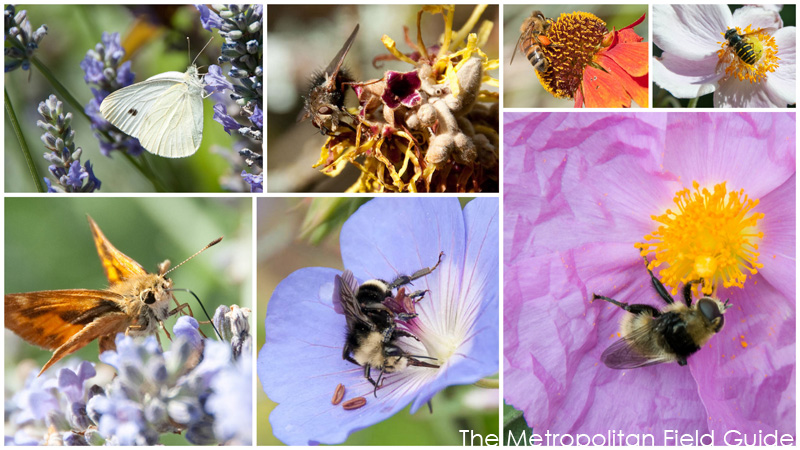
Today marks the beginning of National Pollinator Week, a good time to think about pollinators. Many posts from The Metropolitan Field Guide have focused on pollinators, so to begin Pollinator Week, here is a roundup of the posts. Once you learn about pollinators, visit Pollinator Design and Butterfly and Moth Design for many resources to learn how to design for pollinators.
Why?
- Ecosystem Services: The Pollinators:: It’s estimated that 1/3 of what we eat is a direct result of pollinators.
- Cultural Entomology:: Insects may often be overlooked as important wildlife, but they have a rich history in the lives of humans and there’s now a study of it called Cultural Entomology.
- Book Review: Bugs in the System:: This book introduces basics of insect biology and behavior and delves into the fascinating world of cultural entomologyand their impact on humans.
- Book Review: an obsession with butterflies:: An excellent book for learning about the life history of butterflies from egg through adult with tidbits about their connection with humans throughout history.
Pollinator Plants
- California Poppy:: The California poppy attracts a variety of bees, particularly bumble bees, honey bees and sweat bees, and is mainly pollinated by beetles. Butterflies are also attracted to the poppy nectar.
- Skunk Cabbage:: The scent is to attract the plants pollinators, beetles and flies. One of the principle beetle pollinators is the Rove or Staphylinid beetle (Pelecomalius testaceum) which feeds on the pollen and breeds in the safety of the flower and spathe.
- Oregon-grape:: Painted Lady butterflies and Orchard mason bees are also known to frequent the flowers of Tall Oregon-grape for their nectar. Mining bees and bumble bees in addition to mason bees are the most common visitors.
- Lupine:: Lupine’s will attract hummingbirds and butterflies and has a long history with several species of Blue butterflies such as is the case with the Kincaid lupine and Fender’s blue butterfly.
- Snowberry:: The small, pink, tubular flowers bloom in clusters in the spring, last for about six weeks, and will attract hummingbirds and bees.
Pollinator Profiles
- Bumble Bees:: There are over 250 species world-wide but the majority of them live in the more temperate climates of the northern hemisphere.
- Painted Lady Butterfly:: The Painted Lady is one species found throughout much of the world, on all continents except Antarctica and Australia. They have even been found far out to sea.
- Woodland Skipper Butterfly:: The Woodland Skipper (Ochlodes sylvanoides) is one of the few butterflies that is almost entirely tolerant of urban habitat.
- Mason Bees:: One Blue Orchard Bee can pollinate 2,000 blossoms in a single day, the equivalent of what 100 honeybees can do.
- Urban Bees:: The pollination service bees provide may be crucial to maintaining a healthy ecosystem on the green roof because they enable the flowers to reproduce every year and help to provide habitat on the roof for other wildlife species.
- Book Review: Discovering Moths:: Discovering Moths: Nighttime Jewels in Your Own Backyard
, by John Himmelman, is a truly wonderful book which I really enjoyed reading.
How to Design for Pollinators
- Design for Butterflies:: To attract wildlife to any landscape it’s important to understand the lifeycle of any species in order to create the best design.
- Design for Moths:: Moth species outnumber butterflies in North America 14-1 and they have so many species that in the animal world, only beetles have more.
- Book Review: Attracting Native Pollinators:: Once in awhile there are certain books that come along that every home library must have. Attracting Native Pollinators
is one of those books that should sit on every shelf. It has solidly placed itself as the reference book for designing and attracting pollinators.
- Book Review: Butterflies and Butterfly Gardening in the Pacific Northwest:: This book covers local butterflies, how to attract them and how to landscape for them.
- Biodiversity Ecoroofs:: Among some of the design strategies to creating a good biodiversity roof are good topography with varying substrate depths, shelter from wind and sun.
Pollinator Designs
- Beyond the Hive:: Designs which are aimed at attracting a range of insects including beetles, bees, butterflies, spiders and a variety of others.
- Honey Bee Haven:: The goal of the Honey Bee Haven garden was to provide year-round food sources for honey bees.
- Pollinator Pathway:: The Pollinator Pathway is planned along a one-mile stretch in Seattle from Seattle University to Nora’s Woods replacing grass strips with pollinator gardens.
- Unexpected Habitat:: Once in awhile habitat just happens. It’s not always planned or intended, but there it is. In the city, these habitats can occur just about anywhere, in the tiniest of spaces, often where you least expect them.
- Vancouver’s Green Streets:: The City of Vancouver, in British Columbia, has a successful Green Streets program where residents adopt a corner bulge or traffic circle.
- Seattle University Campus Habitat:: Seattle University sits on 48 acres in the middle of Seattle, a five minute walk east from the middle of downtown.
- Integrated Habitats Design Competition 2010: Satoyama:: This design focuses strongly on the honey bee, colony collapse disorder and how to integrate them into the urban environment.
- Integrated Habitats Design Competition 2010: Happy Habitats:: Roofs are used for honey bee colonies while surrounding landscapes are planted with pollinator plants to provide honey and encourage pollination of crops.
- Integrated Habitats Design Competition 2010: National Wildflower Centre:: The National Wildflower Centre design is collaborative project making use of the elements of nature to influence the form and function of their design.
- Zoro Garden, Balboa Park:: The Zoro Garden has to take the prize for the most interesting history of a butterfly garden. Today the Zoro Garden is an educational butterfly garden.






3 Comments